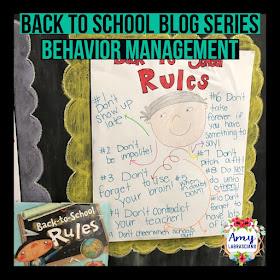Hello there! Welcome back. Make sure to check back every week day because we'll be taking a look at more than 20 different books that are perfect for the k-5 classroom and we don't want you to miss anything. If you have a question that you need answered, make sure to send me an email at amylabrasciano@yahoo.com and I'll see if I have an answer for you. A big thank you to my Instagram friends for sending in so many questions already! (@amylabrasciano)
This is the second post that discusses behavior management. I'll explain my thoughts in the video below, but because I'm so uncomfortable on camera I thought I would put it in writing for you here too. One of my Instagram friends asked what I recommend for behavior management. So here's the thing, I've implemented a lot of different behavior management plans. Each one has been just about as effective as the other. My two favorites are clip charts that go up and down and Dojo. Both have their benefits and drawbacks. There are a lot of teachers who are very vocal about not using the clip chart, while I support their feelings I think if they are done in a consistent respectful way clip charts are just fine. Dojo works nicely because kids get and lose points. The downfall for me was that parents didn't click to see if their children were losing points and why. Dojo shows a total so if they lost a point for being disrespectful, but gained two points because you needed to encourage them to produce work, the parents never saw this behavior and didn't follow up with a conversation. I will use Dojo again, but I will also be sure to have students write how many points were lost in their binders for a parent signature.
More important than consequences and rewards for behavior are ENGAGEMENT and EXPECTATIONS. You can have the best reward system in the world but if you aren't engaging your students in lessons they are going to play around while they should be learning. You can have the best lessons in the world, but if you aren't consistent with expectations then your kids won't know what to do and you will lose them. So instead of worrying about clip charts, you should be planning awesome consistent lessons and an expectation procedure for your classroom. If you want to add engagement to your classroom, check back in my blog. I have published my lessons for free here for over a year. You might also want to give a student interest survey to see what your kids want to learn about. There is a free interest survey
here. It is super easy to teach reading and writing standards while using books that your kids love. While it's a bit more difficult, you can also do it with math, science and social studies. Let's talk about expectations now. You should have a procedure for everything in your classroom. We'll talk about what those procedures are a little later in this series. To set expectations for every lesson consider using CHAMPS. It has worked brilliantly for years in my classroom. It tells students what conversation level you want them on, how to get help, what activity, what movement is allowed in the classroom, how to participate and if they are successful or not. You can buy the book on Amazon used. I have yet to find a program that helps set such great expectations for kids. (Again, they did not pay me to say this I just love them that much!)
For a reward system, I allow students to turn in their Dojo points for a classroom store on Friday. The classroom store sells mostly things that didn't cost me money like: socks in class, change desks, super supplies, lunch with teacher, hat in class, read with a stuffed animal, etc. Before Dojo points we gave out classroom cash and the premise was the same. A lot of emphasis is put on the reward system, but we also have a consistent natural consequence procedure. If students break a rule or procedure after clear expectations have been set and practiced, then they lose a Dojo point. The natural consequence is that they won't get their Friday reward if they don't have enough points. There are also consequences that encourage students to do work. If they don't finish written responses or certain assignments, then they don't get to do center work or other fun learning activities. If there is an ongoing issue with behavior, then you have to dig deeper and connect more with your student. At this point we implement a personal system that works for the student. If by chance you end up with a student who does not respond to your efforts, you just have to keep trying until you reach them. This can be very stressful and wearing, but you can't give up. Just make sure to take care of yourself and take your breaks as needed because your health is very important.
So hopefully you found some value in our post on classroom rules, consequences, expectations and rewards. Make sure to come back every week day to read more.
Thanks so much for stopping by today. If you are looking for a way to increase engagement in your classroom, check out the video below in my TPT store.








































